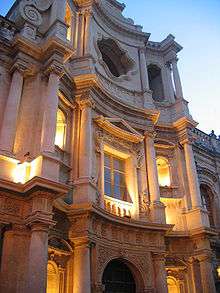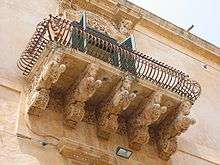Noto
| Noto | ||
|---|---|---|
| Comune | ||
| Città di Noto | ||
|
| ||
| ||
 Noto Location of Noto in Italy | ||
| Coordinates: 36°53′N 15°05′E / 36.883°N 15.083°E | ||
| Country | Italy | |
| Region | Sicily | |
| Province | Siracusa (SR) | |
| Frazioni | see list | |
| Government | ||
| • Mayor | Corrado Bonfanti | |
| Area | ||
| • Total | 550.86 km2 (212.69 sq mi) | |
| Elevation | 152 m (499 ft) | |
| Population (30 November 2017) | ||
| • Total | 24,048 | |
| • Density | 44/km2 (110/sq mi) | |
| Demonym(s) | Notinesi or Netini | |
| Time zone | UTC+1 (CET) | |
| • Summer (DST) | UTC+2 (CEST) | |
| Postal code | 96017 | |
| Dialing code | 0931 | |
| Patron saint | San Corrado Confalonieri | |
| Saint day | February 19 | |
| Website | Official website | |
| UNESCO World Heritage site | ||
| Part of | Late Baroque Towns of the Val di Noto (South-Eastern Sicily) | |
| Criteria | Cultural: (i)(ii)(iv)(v) | |
| Reference | 1024rev-005 | |
| Inscription | 2002 (26th Session) | |
| Area | 21.38 ha (2,301,000 sq ft) | |
| Buffer zone | 48.09 ha (5,176,000 sq ft) | |



Noto (Sicilian: Notu; Latin: Netum) is a city and comune in the Province of Syracuse, Sicily, Italy. It is 32 kilometres (20 mi) southwest of the city of Syracuse at the foot of the Iblean Mountains. It lends its name to the surrounding area[1] Val di Noto. In 2002 Noto and its church were declared a UNESCO World Heritage Site.[2]
History
The old town, Noto Antica, lies 8 kilometres (5 mi) directly north on Mount Alveria. A city of Sicel origin, it was known as Netum in ancient times. In 263 BCE the city was granted to Hiero II by the Romans. According to legend, Daedalus stayed in the city after his flight over the Ionian Sea, as did Hercules after his seventh task. During the Roman era, it opposed the magistrate Verres.

In 866 it was conquered by the Arabs, who elevated the city to become a capital of one of the three districts of the island (the Val di Noto). In 1091, it became the last Islamic stronghold in Sicily to fall to the Christians.[3] Later it became a rich Norman city.
In the 16th and 17th centuries, the city was home to several notable intellectual figures, including Giovanni Aurispa, jurists Andrea Barbazio and Antonio Corsetto, as well as architect Matteo Carnelivari and composer Mario Capuana. In 1503 king Ferdinand III granted it the title of civitas ingeniosa ("Ingenious City"). In the following centuries, the city expanded, growing beyond its medieval limits, and new buildings, churches and convents were built. These, however, were all totally destroyed by the 1693 Sicilian earthquake.
The current town, rebuilt after the earthquake on the left bank of River Asinaro, was planned on a grid system by Giovanni Battista Landolina. The new city occupied a position nearer to the Ionian Sea. The hiring of architects like Rosario Gagliardi, Francesco Sortino and others to rebuild the city helped make the new Noto a masterpiece of Sicilian Baroque, dubbed the "Stone Garden" by Cesare Brandi and is currently listed among UNESCO's World Heritage Sites. Many of the newer structures are built of a soft tufa stone, which assume a honey tonality under sunlight. Parts of the cathedral suddenly collapsed in 1996, a great loss to Sicilian Baroque architecture.
The city, which had lost its provincial capital status in 1817, rebelled against the House of Bourbon on 16 May 1860, leaving its gates open to Giuseppe Garibaldi and his expedition. Five months later, on 21 October, a plebiscite sealed the annexation of Noto to Piedmont.
In 1844, Noto was named a Diocese, but in 1866 suffered the abolition of the religious guilds, which had been deeply linked to the city's structures and buildings.
Noto was freed from the fascist dictatorship of Benito Mussolini in July 1943. The Notinesi people voted in favour of the monarchy in the referendum of 1946.
Main sights
Noto is famous for its fine buildings of the early 18th century, many of which are considered to be among the finest examples of Sicilian baroque style. It is a place of many religious buildings and several palaces.
Palazzi and other buildings
- Palazzo Ducezio, the current town hall. Designed by Vincenzo Sinatra, it houses neo-classical style frescos by Antonio Mazza.
- Palazzo Astuto.
- Palazzo di Villadorata on via Nicolaci which was built by P. Labisi in 1733.
Religious buildings
- Noto Cathedral (Cattedrale di San Nicolò di Mira, finished in 1776).
- Church of Santa Caterina.
- Church of San Corrado.
- Church of the Collegio di San Carlo.
- Church of the Sacro Nome di Gesu.
- Monastery of Santa Chiara (1735), designed by Gagliardi. It has an oval plant, the interior divided by twelve columns housing a Madonna with Child from the 16th century.
- Church of San Michele Arcangelo.
- Church of Santa Maria della Scala.
- Church of Santissimo Salvatore.
- Town Library.
- Church of San Nicola di Mira.
- Church of Santa Chiara, with a precious Madonna (by Antonello Gagini).
- Church of San Francesco d'Assisi (Immacolata).
- Church of the Spirito Santo.
- Church of Ecce Homo.
- Church of Santa Maria dell'Arco.
- Church of the Anime Sante del Purgatorio ("Holy Souls of the Purgatory").
- Church of Santa Maria della Rotonda.
- Church of the Santissima Trinità.
- Church of San Carlo al Corso (by Rosario Gagliardi).
- Church of Santa Maria del Carmelo.
- Church of San Pietro Martire.
- Church of San Michele Arcangelo.
- Church of San Domenico (by Rosario Gagliardi).
- Church of Sant'Antonio Abate.
- Church of Santa Caterina.
- Church of the Crociferio di San Camillo.
- Church of Montevergine (San Girolamo).
- Church of Santissimo Salvatore.
- Church of San Andrea Apostolo.
- Church of San Pietro delle Rose (Saints Peter and Paul).
- Church of the SS. Crocifisso.
- Church of Sant'Egidio Vescovo.
- Church of Santa Maria del Gesù.
- Church of Annunziata.
- Church of Santa Agata.
Archaeological sites
The remains of Noto's ancient structures are almost entirely hidden beneath the ruins of the mediaeval town, except for three chambers cut into the rock. One is noted by an inscription in the library at Noto to have belonged to a gymnasium, while the other two were heroa (shrines of heroes). Explorations have discovered four cemeteries dating to the third Sicel period and one from the Greek period. Among other finds are catacombs of the Christian period and several Byzantine tombs.
About 6 kilometres (4 mi) south of Noto, on the left bank of the Tellaro (Helorus) river, stands a stone column about 10 metres (33 ft) high, which is believed to be a memorial to the surrender of Nicias. In the 3rd century BC, a tomb was excavated in the rectangular area which surrounds it, destroying an apparently pre-existing tomb. Remnants of a later burial site belonging to the necropolis of the small town of Helorus, 750 metres (2,460 ft) to the southeast, have been discovered. The Villa Romana del Tellaro is a Roman villa located south of Noto.
Culture
In the Noto neighbourhood, a 32-m radiotelescope was installed by the Istituto di Radioastronomia di Bologna as part of the Consiglio Nazionale delle Ricerche. It works in collaboration with a similar instrument in Medicina, Bologna.
The city has held an annual flower festival, the Infiorata, every May since the 1980s, lining the Corrado Nicolaci with floral mosaics.[4]
Frazioni
Baulì, Buonivini (meaning "good wines"), Calabernardo, Castelluccio, Cipolla, Coda di Lupo, Falconara, Fondo Morte, Lenzavacche, Lido di Noto, Madonna Marina, Pantano Longarini, Pietà San Giovannello, Reitani, Rigolizia, San Corrado di Fuori, San Lorenzo, San Marco, San Paolo, Santa Lucia, Serra di Vento, Testa dell'Acqua, Vendicari and Villa Vela.
Economy
The local area is home to several quality wine producers.
Photogallery
 Theatre
Theatre- Noto Cathedral
 Church of San Domenico
Church of San Domenico Church of St. Charles Borromeo
Church of St. Charles Borromeo Church of San Francesco all'Immacolata
Church of San Francesco all'ImmacolataChurch of the Carmine  Arch
Arch Church of the Santissimo Crocifisso
Church of the Santissimo Crocifisso- Church of Santa Chiara

Via Nicolaci
See also
References
- Sicily and Its Islands, 2004 - Ugo La Rosa editore
- ↑ The Val in Val di Noto is in Sicilian and in Italian a grammatically masculine term, and it does not refer to a "Valley" as is usual in Italian geographical names, which are although always grammatically feminine, but to one of the Provinces or Governorates into which Sicily was administratively divided under the Arab rule and up until the 1812 administrative reform. The corresponding Arab term is Wāli, and the Sicilian Val is akin to the Arab Wilayah or the Turkish Vilayet, used as it would be a calque of the English term Shire
- ↑ Late Baroque Towns of the Val di Noto - listing on UNESCO website
- ↑ Jeremy Johns (7 Oct 2002). Arabic Administration in Norman Sicily: The Royal Diwan. Cambridge University Press. p. 31. ISBN 9781139440196.
- ↑ L'INFIORATA di NOTO( Noto's Flower Festival )NOTO on-line: City of Noto, Unesco World Heritage Site


